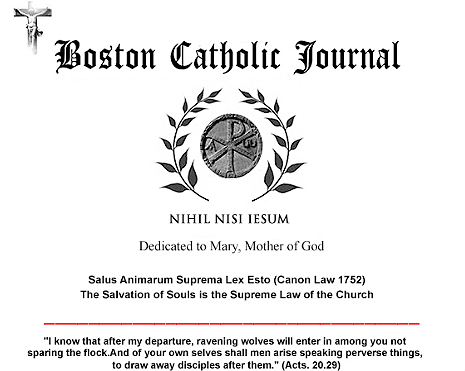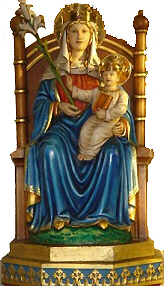|

Our Lady of Walsingham

A Saxon House and the
Seat of the Queen
... of Heaven
Nearly
a thousand years ago – 944 to be exact – two
women, a child, and a dream, commingled time and
place, bringing Nazareth to a small village in East
Anglia, England ... and into the hearts and lives
of men and women ever since. To this day you can
stand at the threshold of Heaven and Earth. Every
year thousands do, from all over the world. Why
do they come? What do they do? And what do they
leave with?
Our Lady of Walsingham: a Pilgrimage
through Time
In
the middle ages medieval man and woman held before
them as an ideal, an ambition to make at least once
in their life-time a pilgrimage to one of the great
shrines of Christendom. The four great shrines of
medieval Christendom were Jerusalem with its opportunity
to visit the holy places and to walk in the foot-
steps of the Master, to walk upon the ground that
Jesus Christ Himself had hallowed with His presence.
Rome, in particular the tombs of the Apostles, St.
Peter and St. Paul, the Coliseum and the cemeteries
of the early Christian martyrs, the Catacombs ...
and to Walsingham in Norfolk, England to visit the
Holy House of Nazareth that housed the Statue of
Our Lady of Walsingham. It is significant that the
English Shrine was the only one dedicated to Mary,
the Mother of God.
There were various motivations for the making of
medieval pilgrimages, a desire to do penance for
sins, ones own or others, a trust to be healed of
some disease or suffering by visiting the tomb of
a St., for spiritual renewal, guidance, blessing,
the seeking of favours, pilgrimage was a highly
valued and esteemed Christian practice, and certainly
for all those living in England, Walsingham was
the most accessible and easiest to arrive at.
A Pilgrimage of its nature always implies effort
and perseverance, the willingness to accept deprivation
and difficulty, an adjustability to the unexpected,
it can be a real experience of dying to oneself
and cause us to exercise a very real spiritual poverty.
In this lies its potential value of calling us onwards
to the goal, forgetful of self for some greater
good, for ourselves or others, and an exercise that
will certainly and did certainly sharpen the spiritual
wits and bring the pilgrim invariably closer to
God from the experience.
Many future Saints and martyrs as well as numerous
Kings and Queens plus countless numbers of ordinary
people sought their guidance from Christ and Mary
and the Saints, by means of going on pilgrimage
to the places where they were specifically honoured.
Indeed Walsingham was so well known that it is said
that at some time in his or her life every English
man and woman regardless of their station in life,
visited Our Lady of Walsingham, according to the
English chronicler, Holinshead, the so called
Pilgrims Way (the road to Walsingham) was given
the first place among all the roads in England.
It is interesting to note that Walsingham was a
popular place of pilgrimage 800 years before Lourdes.
Where is Little Walsingham?
Little Walsingham
is a beautiful English country village hidden away
in a Norfolk Dale in the County of East Anglia on
the eastern side of England. Walsingham is intersected
by the river Stiffkey. It is over 100 miles from
London, and 28 miles north-west of Norwich. Its
nearest sea port is called Wells, only 5 miles away,
but in former times the crowds of pilgrims who came
by sea would land at King’s Lynn, or Bishop’s Lyn,
as it was then called.
Walsingham's other means of approach are various
winding country lanes and roads, especially the
so called Pilgrims Way. Walsingham is a beautiful
little village which stills retains much of its
medieval atmosphere, the close knit houses, many
of them in the Jacobean half timbered design, the
central market area, called the Friday market, the
presence of the ancient ruins of the Franciscan
Friary (Grey-Friars) on the south side of the village
, the majestic and imposing ruins of the actual
great Augustinian Priory in the Abbey grounds ,
plus the two Holy Wells, and other factors all add
to this.
The very names of its streets and lanes are reminiscent
of a bygone age, Church Street, Almonry Lane, Thorn
Gate, to name a few. Walsingham is extremely picturesque
and rural, it takes very little in the way of imagination
to feel that one is walking and praying in medieval
England. The whole place is steeped in history,
the very stones are saturated with prayer, one knows
instinctively that this is a place where a great
drama has been re-enacted, and that of the entire
Pascal mystery.
The Spiritual Inspiration and Founding
of the Shrine at Walsingham
Walsingham has been
a place of pilgrimage since 1061.The earliest written
account of the founding of the National Shrine of
Our Lady of Walsingham to survive is in the ‘Walsingham
Ballard’ (c.1465) included in book 1254 in the Pepys
library at Magdalen College, Cambridge. England.
In 1061, when St. Edward the Confessor was King
of England, five years before the Norman conquest,
a lay of the village, a widow, a certain Richeldis
de Faverches was captivated by the Holy Spirit,
as it were in a new Annunciation from the Lord,
she received an inner vision and understanding from
the Virgin Mary, Mother of God. The Lady Richeldis
was taken up as it were in the Spirit and was shown
the very house where Mary herself had been told
by the Angel Gabriel that she would be the Mother
of God, the Lady Richeldis then understood in this
vision by both Mary's words and indications that
she was to be instrumental in building another such
holy house like this in Walsingham, Our Lady promised
the Lady Richeldis ' Whoever seeks my help there
will never go away empty handed'.
It was this vision that conceived and gave birth
to the whole Walsingham Story, Walsingham
was to become a new Nazareth. Mary actually
appeared three times to the Lady Richeldis, each
time in a vision set in the Holy family's home at
Nazareth where Jesus lived with Mary and Joseph.
So Mary, the Mother of God, chose Walsingham herself
for such a mission, for God's purpose.
The Mother of God indicated the construction of
the house, regarding size and indicated the very
spot where she desired the house to be. Mary said
to the Lady Richeldis, “Do all this unto my special
praise and honour. And all who are distressed or
in need, let them seek me here in that little house
you have made me in Walsingham. To all that seek
me there I will give my help. And there at Walsingham
in this little house shall be held in remembrance
the great joy of my salutation when St Gabriel told
me should through humility become the Mother of
God’s Son”.
From this vision of Mary comes the enduring devotion
of the English to the Salutation, more commonly
referred to as the Annunciation. As Mary the Mother
of God bore the Saviour of the World through offering
her simple, Fiat, by her gift of obedience
to the inspiration and direction of the Holy Spirit,
so the life of another lady, the Lady Richeldis
bore fruit because of her obedience, her listening
and putting into a concrete reality the invitation
and desires of Mary, Our Queen and Mother. The lady
Richeldis had the house built as she was requested.
It was a simple wooden Saxon house and no attempt
was made to imitate a Palestinian structure.
After the death of the Lady Richeldis, her son Geoffrey
de Faveraches, now Lord of the Marches, and Lord
of the manor decided to fulfill his life long ambition
to journey to the Holy Land to see the original
'Holy House' in Nazareth. But before leaving he
gave directives to his chaplain to institute a religious
order to care for the chapel of Our Lady. Eventually
the shrine was to be sheltered by the great conventual
church that sprang up beside it, a priory of the
Austin Canons. So it was that the priory and the
shrine stood side by side for centuries.
The actual wooden shrine stood on the north side
of the church, and was entered by a door from the
church and had its own means of exit for the continuing
streams of pilgrims, at some later later the shrine
was encased be a stone building, probably for its
protection and preservation. So it was that Walsingham
became a great centre of pilgrimage, Kings and Queens,
monks and religious, minstrels, paupers, peasants,
people of every age and state came to pay homage
to Mary in this beautiful Nazareth of England, a
blessed hallowed spot chosen by the Mother of God
herself.
It is still there
today. Still the pilgrims come. She came to us.
Perhaps one day you will go to her. If you cannot,
you still can ... for it is,
she is, only a prayer away. She always
is.
Editor
Boston Catholic Journal
Comments? Write us:
editor@boston-catholic-journal.com

Totally Faithful
to the Sacred Deposit of Faith
entrusted to the Holy See in Rome
“Scio
opera tua ... quia modicum habes virtutem,
et servasti verbum Meum, nec non negasti
Nomen Meum”
“I
know your works ... that you have but
little power, and yet you have kept
My word, and have not denied My Name.”
(Apocalypse 3.8)
Copyright © 2004 - 2025
Boston Catholic Journal. All rights
reserved. Unless otherwise stated, permission
is granted by the Boston Catholic Journal
for the copying and distribution of
the articles and audio files under the
following conditions: No additions,
deletions, or changes are to be made
to the text or audio files in any way,
and the copies may not be sold for a
profit. In the reproduction, in any
format of any image, graphic, text,
or audio file, attribution must be given
to the Boston Catholic Journal.
|
|